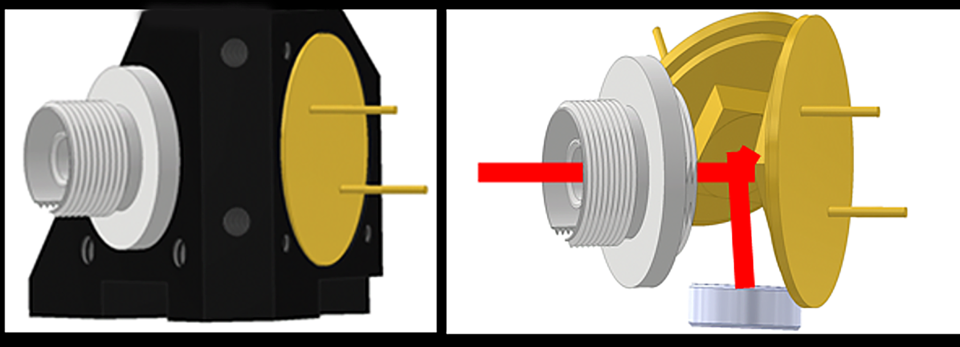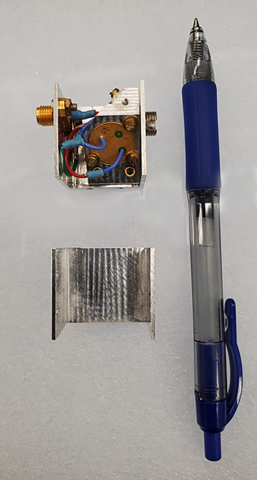Infrared Trap Detector

(Left) Outer housing of trap detector. (Right) Interior of detector showing both sensors and light path in red.
The Technology
Numerous applications in medicine, industry and science require extremely accurate detection and counting of single photons to measure optical power or to calibrate other detectors and sources. To fill that need, NIST researchers are developing a low-cost device smaller than a golf ball that traps more than 99% of incident infrared (IR) photons using a dual sensor system with very low measurement uncertainties.
Single-photon detectors can have very high internal conversion efficiency, by which we mean here that each absorbed photon is converted to a single electron in a photodiode sensor. Optical power can thus be determined by measuring the electrical current generated, which is readily accomplished with high accuracy (if the wavelength of the light is known). The main problem with all existing optical power measurements is determining how much of the light is absorbed versus how much is lost due to reflection or transmittance through the detector. That situation makes it difficult to calculate measurement uncertainties in some wavelengths, particularly the low-energy infrared wavelengths used in telecom and other applications.
In the NIST design, an incoming IR photon is directed for measurement to the first sensor, which has high absorption but also partially reflects. That reflected light then strikes a second sensor, where more of the light is absorbed and another measurement is made. Thus, for example, a first sensor with 10% reflectivity would capture 90% of the light, and the second sensor would catch 90% of the reflected beam. The two together would trap and register 90% plus 9%, or 99% of the total light. Using a third sensor to catch light reflected from the second allows the total light caught to reach 99.9%.
Advantages Over Existing Methods

The primary advantage of this new technology is that it is specifically designed for IR wavelengths, substantially extending measurement range beyond the visible-wavelength devices that are currently available. It also makes it much easier to accurately characterize other detectors being tested as well as light sources in the IR range.
One common conventional method of calibrating a single-photon IR detector employs an attenuated laser source. This method, however, requires accurate knowledge of the laser power at nanowatt levels, attainable by using a calibrated optical power meter traceable to a primary standard such as a cryogenic radiometer. However, it is costly and time-consuming to calibrate and recalibrate detectors used as laboratory standards or transfer standards (devices used to compare two other standards). Therefore, this conventional approach is not available to many users.
The NIST IR trap detector should enable self-testing that minimizes the need for a frequent recurring calibration service. Prior experience with silicon trap detectors for visible photons shows that when they are remeasured many years later, their performance is largely unchanged. Because that design is robust, it should therefore be similar for IR traps.
In addition, self-checking is comparatively simple. Instead of measuring the sum output of the two sensors, each can be measured separately. If there is a change in the ratio of the outputs from each sensor — then something is wrong. If it the ratio is unchanged, the initial characterization is probably accurate.
The new design can also improve confidence in measurements. Existing visible-frequency optical power meters typically have uncertainties between about 2%-5%. NIST’s new IR detector should be able to achieve uncertainties of 0.5% to 1%. The design uses smaller detectors and produces a more compact and presumably less costly device. This smaller size has the additional benefit that the smaller detectors allow for a lower noise floor and higher maximum gain, so the device will be able to measure low power levels.
Applications
Quantum networks in development will use single photons in the telecom band around 1310 nanometers (nm) to 1550 nm. Such networks will demand high-accuracy single-photon detectors and light sources at those near-IR wavelengths.
Because the NIST detector is likely to have a similar or lower production cost than existing devices, its use in room-temperature applications should be quite wide. Almost anywhere a conventional power meter is currently used (i.e., in a lab or commercial setting), this improved-accuracy version could be used.
Publications
Rahmouni, Anouar; Gerrits, Thomas; Migdall, Alan; Slattery, Oliver; Shaw, Ping-Shine; and Rice, Joseph P. A self-validated detector for characterization of quantum network components. Conference on Lasers and Electro-Optics (CLEO). May 2022.
Gerrits, Thomas; Migdall, Alan; Bienfang, Joshua C.; Lehman, John; Nam, Sae Woo; Splett, Jolene; Vayshenker, Igor; and Wang, Jack. Calibration of free-space and fiber-coupled single-photon detectors. Metrologia. Published online Dec. 20, 2019. DOI: 10.1088/1681-7575/ab4533
Contacts
-
(301) 975-2331

